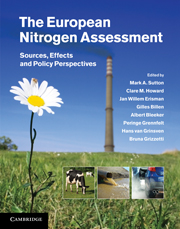Book contents
- Frontmatter
- Contents
- List of contributors
- Foreword
- Summary for policy makers
- Technical summary
- 1 Assessing our nitrogen inheritance
- Part I Nitrogen in Europe: the present position
- Part II Nitrogen processing in the biosphere
- Part III Nitrogen flows and fate at multiple spatial scales
- Part IV Managing nitrogen in relation to key societal threats
- Part V European nitrogen policies and future challenges
- Glossary
- Index
Technical summary
Published online by Cambridge University Press: 16 May 2011
- Frontmatter
- Contents
- List of contributors
- Foreword
- Summary for policy makers
- Technical summary
- 1 Assessing our nitrogen inheritance
- Part I Nitrogen in Europe: the present position
- Part II Nitrogen processing in the biosphere
- Part III Nitrogen flows and fate at multiple spatial scales
- Part IV Managing nitrogen in relation to key societal threats
- Part V European nitrogen policies and future challenges
- Glossary
- Index
Summary
Part I Nitrogen in Europe: the present position
Nitrogen inheritance
1. Gaseous di-nitrogen (N2) constitutes 78% of the earth's atmosphere. It is a rather inert chemical, being nearly unavailable for the biological cycle. The other nitrogen forms are much more reactive; these include nitrate (NO3−), ammonium (NH4+) and ammonia (NH3), gaseous nitrogen oxides (NOx), nitrous oxide (N2O) and many other inorganic and organic nitrogen forms. Collectively, they are termed ‘reactive nitrogen’ (Nr). They are normally scarce in natural environments, with their low availability limiting the productivity of natural ecosystems. This was also the case for agricultural production before 1900, which long remained dependent on the recycling of Nr in human waste and manure, and the capacity of legumes to fix atmospheric N2 biologically.
2. With a growing human population through the nineteenth century and the need for more Nr, Europe increasingly operated a ‘fossil nitrogen economy’, dependent on the addition of nitrogen fertilizers from mined sources, including from guano, coal and saltpetre. The ‘nitrogen problem’ of the time was that these sources were fast becoming insufficient to meet Europe's escalating need for fertilizer Nr, and its military need for Nr in explosives [1.1].
- Type
- Chapter
- Information
- The European Nitrogen AssessmentSources, Effects and Policy Perspectives, pp. xxxv - liiPublisher: Cambridge University PressPrint publication year: 2011
- 13
- Cited by

